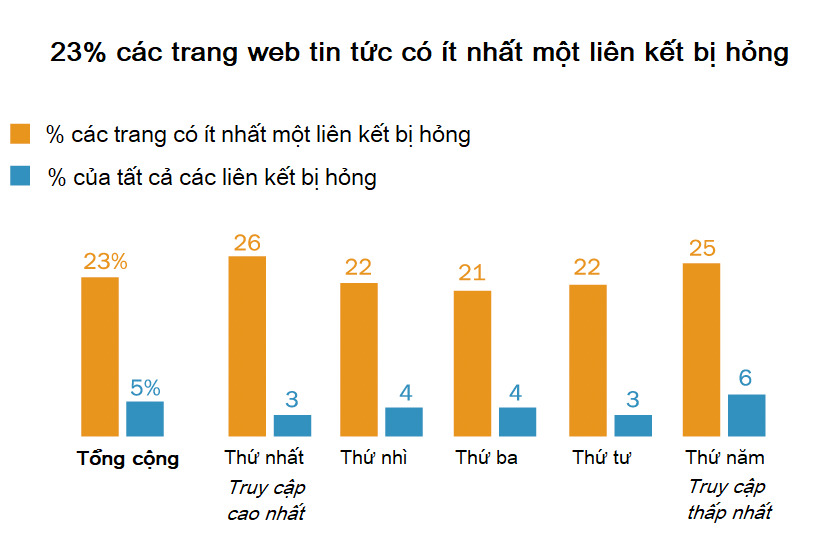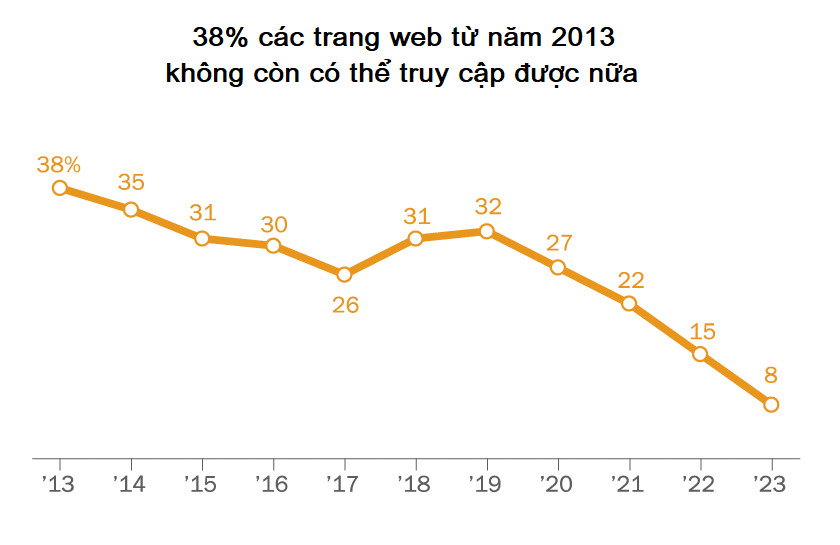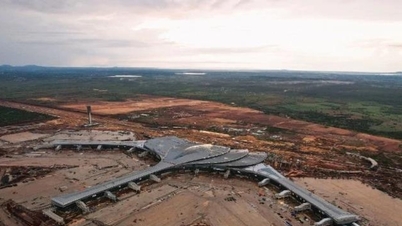(NB&CL) An alarming trend shows that readers and publishers no longer attach importance to keeping news on the internet, in a world where readers are only focusing on fast news, short videos that are read and then forgotten and never returned. It is alarming that human knowledge is being lost.
38% of websites disappear after a decade
The internet is a vast archive of modern life, with hundreds of billions of indexed web pages. But even as users around the world rely on the web to access books, images, news articles, and other resources, this content sometimes disappears.
A new analysis by the Pew Research Center shows just how ephemeral online content truly is: As of October 2023, a quarter of websites that existed between 2013 and 2023 are no longer accessible. Notably, 38% of websites that appeared in 2013 alone are no longer accessible a decade later. Note that this includes standalone websites or dedicated sites for organizations.

Online information and knowledge are disappearing as readers are drawn into social networks or AI chatbots. Illustration: The Conversation
It is a warning that despite the hype surrounding the digital age, many quality news sources (including journalism) are failing to survive, let alone thrive. It is clear that this is partly because advertising revenue has flowed into the social media platforms of the Big Tech giants, so the agencies or individuals who own websites are no longer interested in maintaining or developing them.
This means that users around the world, including newspaper readers in the past, are flocking to social networks or sharing platforms to enjoy moments of instant information satisfaction (often sensational or entertaining), instead of looking for in-depth and valuable sources of information as before. As a result, these types of knowledge or press sites are no longer respected, leading to weakening and then disappearing (note that it is necessary to pay monthly or yearly to maintain a website).
Alarm about the “digital recession”
It’s called “digital decay,” and it’s happening in a variety of online spaces. Pew’s research looked at both content links on government and news sites, as well as in the “References” section of Wikipedia pages as of October 2023. They found that 23% of news sites had at least one broken link, compared to 21% of sites from government sites, which are more well-funded and have more stable funding.

Broken links on news sites, by site traffic rank. Graphic source: Pew Research Center

Percentage of online links that are no longer accessible by year (as of October 2023). Graphic source: Pew Research Center
In fact, high-traffic news sites and low-view sites are equally likely to have broken links. Local government sites are especially likely to have broken links. Furthermore, 54% of Wikipedia pages—the world’s open encyclopedia—have at least one link in the “References” section that is not accessible (i.e., the links at the bottom of the page that cite information for the content above).
It’s not just websites or information pages that are increasingly at risk of being corrupted or deleted; digital decay is also taking place on today’s trendy social networks. For example, a Pew study found that nearly one-fifth of “tweets” are no longer publicly visible on Social Network X (formerly Twitter) just months after they were posted. In 60% of these cases, the account that originally posted the tweet was made private, suspended, or deleted entirely. In the remaining 40%, the account owner deleted the tweet.
Thus, searching or looking up information or knowledge on X, as well as on many other social networks, is not trustworthy. Therefore, it would be worrying to believe that social networks or other sharing platforms can replace traditional online news sources or other forms of physical knowledge storage.
Most tweets are deleted after posting. According to Pew statistics, most tweets deleted from the site tend to disappear shortly after being posted. Specifically, half of tweets that are subsequently deleted from the platform are unavailable within the first 6 days after being posted. 1% of tweets are deleted within an hour; 3% of tweets are deleted within a day; 10% of tweets are deleted within a week; 15% of tweets are deleted within a month. |
Huy Hoang
Source: https://www.congluan.vn/khi-thong-tin-bien-mat-post328132.html


















































































































Comment (0)